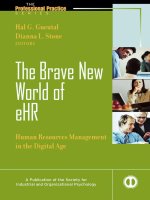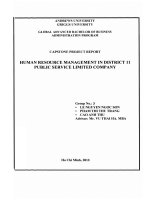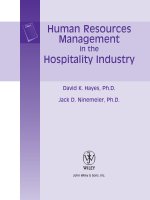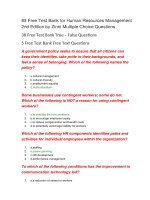Test bank human resources management in canada 13th ch1
Bạn đang xem bản rút gọn của tài liệu. Xem và tải ngay bản đầy đủ của tài liệu tại đây (71.81 KB, 16 trang )
Human Resources Management in Canada, 13e (Dessler/Chhinzer)
Chapter 1 The Strategic Role of Human Resources Management
The Strategic Role of Human Resources Management
1) According to the textbook's definition of human resources management, this field involves
A) management techniques for controlling people at work.
B) concepts and techniques used in leading people at work.
C) the management of people in organizations.
D) all managerial activities.
E) concepts and techniques for organizing work activities.
Answer: C
Type: MC Page Ref: 2
Topic: The Strategic Role of Human Resources Management
2) The knowledge, education, training, skills, and expertise of a firm's workers are known as
A) management's philosophy.
B) human capital.
C) physical capital.
D) production capital.
E) cultural diversity.
Answer: B
Type: MC Page Ref: 2
Topic: The Strategic Role of Human Resources Management
3) HRM involves formulating and implementing HRM systems that are aligned with the
organization's strategy to ensure the workforce has competencies and behaviours required to
achieve the organization's strategic objectives.
Answer: TRUE
Type: TF Page Ref: 2
Topic: The Strategic Role of Human Resources Management
4) Define and briefly describe the term "human resources management."
Answer: Five points recommended: 2 for a definition that is close to the textbook ("management
of people in organizations") and 3 for being able to identify something close to "formulating and
implementing HRM systems (such as recruitment, performance appraisal, and compensation)
that are aligned with the organization's strategy…"
Type: ES Page Ref: 1
Topic: The Strategic Role of Human Resources Management
1
© 2017 Pearson Canada Inc.
A Brief History of HRM
1) What term describes the right to make decisions, direct others' work, and give orders?
A) Management
B) Responsibility
C) Obligation
D) Power
E) Authority
Answer: E
Type: MC Page Ref: 6
Topic: A Brief History of HRM
2) Sheila is an HR Manager and advises the Sales Manager on how to recognize candidates with
job-relevant attributes during the interview process. What type of manager is Sheila?
A) General manager
B) Operational manager
C) Line manager
D) Staff manager
E) Administrative manager
Answer: D
Type: MC Page Ref: 6
Topic: A Brief History of HRM
3) The process of analyzing manufacturing processes, reducing production costs, and
compensating employees based on their performance levels, is found in
A) the human relations movement.
B) scientific management.
C) the scientific movement.
D) the human resources movement.
E) the concern for people and productivity.
Answer: B
Type: MC Page Ref: 3
Topic: A Brief History of HRM
4) Which of the following was emphasized in Frederick Taylor's theory of HRM?
A) Empowerment of employees
B) Cross-functional cooperation
C) Compensation tied to performance
D) Work conditions
E) Job rotation
Answer: C
Type: MC Page Ref: 3
Topic: A Brief History of HRM
2
© 2017 Pearson Canada Inc.
5) Management practices in the late 1800s and early 1900s emphasized
A) self-management.
B) workplace harmony.
C) higher wages.
D) empowerment.
E) task simplification and performance-based pay.
Answer: E
Type: MC Page Ref: 3
Topic: A Brief History of HRM
6) Mary Parker Follett was a(n)
A) advocate of self-management and empowerment.
B) advocate of scientific management.
C) supporter of the view that workers are disengaged at work.
D) advocate of authoritarian management.
E) advocate of the motivational power of money.
Answer: A
Type: MC Page Ref: 4
Topic: A Brief History of HRM
7) HR responsibilities have shifted from operational to strategic responsibilities, which involve
formulating and executing organizational strategy.
Answer: TRUE
Type: TF Page Ref: 3
Topic: A Brief History of HRM
The Human Resources Movement: Concern for People and Productivity
1) Which of the phases of the human resources movement included HR professionals serving as
subject-matter experts or in-house consultants to line managers offering advice on HR-related
matters?
A) Phase 1
B) Phase 2
C) Phase 3
D) Phase 4
E) Phase 5
Answer: D
Type: MC Page Ref: 5
Topic: The Human Resources Movement: Concern for People and Productivity
3
© 2017 Pearson Canada Inc.
2) The practice of contracting with outside vendors to handle specified functions on a permanent
basis is known as
A) payroll and benefits administration.
B) outsourcing.
C) labour-management relations.
D) contract administration.
E) hiring temporary employees.
Answer: B
Type: MC Page Ref: 4
Topic: The Human Resources Movement: Concern for People and Productivity
3) When orientation, performance appraisal, and employee relations responsibilities were added
to the job of personnel managers, this was part of
A) socialism.
B) scientific management.
C) sociology.
D) the human relations movement.
E) psychology.
Answer: D
Type: MC Page Ref: 4
Topic: The Human Resources Movement: Concern for People and Productivity
4) Which of the following activities was part of the traditional role of personnel administration in
the early 1900s?
A) Hiring and firing employees
B) Environmental scanning
C) Coaching and mentoring employees
D) Being part of the strategic planning discussions
E) Handling union-management relations
Answer: A
Type: MC Page Ref: 4
Topic: The Human Resources Movement: Concern for People and Productivity
5) In the early 1900s, personnel administration, as it was called then,
A) focused on trying to improve the human element in organizations.
B) served a key advisory role in organizations.
C) was closely tied to union-management relations.
D) was highly influenced by laws and regulations.
E) played a very minor role in organizations.
Answer: E
Type: MC Page Ref: 4
Topic: The Human Resources Movement: Concern for People and Productivity
4
© 2017 Pearson Canada Inc.
6) The second phase of the human resources movement arrived in the 1930s with
A) a decrease in unionizing activities.
B) minimum wage legislation.
C) pay equity legislation.
D) employment equity acts.
E) health and safety legislation.
Answer: B
Type: MC Page Ref: 4
Topic: The Human Resources Movement: Concern for People and Productivity
7) If you were an HR professional in the 1940s or 1950s, you would likely have had which of the
following activities added onto your portfolio of existing responsibilities?
A) Handling orientation and performance appraisals
B) Running the payroll department
C) Hiring and firing
D) Focusing on self-management
E) Administering benefits
Answer: A
Type: MC Page Ref: 4
Topic: The Human Resources Movement: Concern for People and Productivity
8) The third major phase in personnel management was a direct result of
A) the government legislation passed that affected employees' human rights, wages and benefits,
working conditions, and health and safety.
B) the impact of the scientific management movement.
C) a desire for professionalism.
D) government intervention during the depression of the 1930s.
E) an increase in unionizing activities.
Answer: A
Type: MC Page Ref: 4
Topic: The Human Resources Movement: Concern for People and Productivity
9) The fourth phase of HRM is the current phase and suggests that
A) the goals and aims of management must be achieved at all costs.
B) employees are motivated primarily by compensation and benefits.
C) social influences are no longer important to most employees.
D) employees are quite similar in terms of the rewards they seek.
E) all potential managers must be aware of the basics of HR.
Answer: E
Type: MC Page Ref: 5
Topic: The Human Resources Movement: Concern for People and Productivity
5
© 2017 Pearson Canada Inc.
Human Resource Manager's Duties
1) According to an analysis of a Hewitt Associates database, there is a strong positive
relationship between employee engagement and
A) employee recognition.
B) diversity programs.
C) organizational performance.
D) job design indicators.
E) social activities.
Answer: C
Type: MC Page Ref: 7
Topic: Human Resource Manager's Duties
2) The company's plan for how it will balance its internal strengths and weaknesses with external
opportunities and threats to maintain a competitive advantage is known as
A) company objectives.
B) environmental scanning.
C) strategy.
D) policies and procedures.
E) SWOT.
Answer: C
Type: MC Page Ref: 8
Topic: Human Resource Manager's Duties
3) Rita is the HR Director of a manufacturing company. She recently undertook research to
identify competitor compensation and incentive plans, information about pending legislative
changes, and availability of talent in the labour market for the upcoming strategic planning
meeting. Rita was engaging in
A) strategy formulation.
B) cost analysis.
C) environmental scanning.
D) external market surveying.
E) internal threat analysis.
Answer: C
Type: MC Page Ref: 8
Topic: Human Resource Manager's Duties
4) Engaged employees drive desired organizational outcomes by going beyond what is required
and understanding and sharing the values and goals of the organization.
Answer: TRUE
Type: TF Page Ref: 7
Topic: Human Resources Manager's Duties
6
© 2017 Pearson Canada Inc.
5) Recent research indicates that there is a strong positive relationship between employee
engagement and organizational performance indicators, such as sales growth and total
shareholder return.
Answer: TRUE
Type: TF Page Ref: 7
Topic: Human Resource Manager's Duties
6) HR professionals are expected to be change agents who lead the organization and its
employees through organizational change.
Answer: TRUE
Type: TF Page Ref: 8
Topic: Human Resource Manager's Duties
Measuring the Value of HR: Metrics
1) If a company uses a measurement system that compliments financial measures with
operational measures of organizational, business unit, or department success that will drive
future performance, then this company is using a system known as the
A) HRIS.
B) balanced scorecard.
C) Human Capital Index.
D) complimentary strategy.
E) human capital competency.
Answer: B
Type: MC Page Ref: 10
Topic: Measuring the Value of HR: Metrics
2) According to the textbook, which of the following is now being used more commonly to
measure the activities and results of human resources?
A) Metrics
B) Academic research evidence
C) Science
D) Strategy
E) Subjective popular press articles
Answer: A
Type: MC Page Ref: 10
Topic: Measuring the Value of HR: Metrics
7
© 2017 Pearson Canada Inc.
Growing Professionalism in HRM
1) Which of the following is the lowest level (i.e., Level-1) of HR certification currently
available?
A) CHRL
B) CHRC
C) CHRP
D) CHRA
E) CHRE
Answer: C
Type: MC Page Ref: 11
Topic: Growing Professionalism in HRM
2) The Canadian national body that manages certification for human resource professionals is
called the
A) Canadian Management Association.
B) Canadian Council of Human Resources Associations.
C) Society for Human Resources Management.
D) Personnel Professionals Association of Ontario.
E) Personnel Management Association of Canada.
Answer: B
Type: MC Page Ref: 11
Topic: Growing Professionalism in HRM
3) Certified HRM professionals must abide by a uniform code of ethics to maintain professional
status.
Answer: TRUE
Type: TF Page Ref: 13
Topic: Growing Professionalism in HRM
Environmental Influences on HRM
1) HRM has evolved over the last few decades due to external environmental influences, such as
globalization, technological changes, and environmental concerns, all of which drive the
strategic focus of HRM.
Answer: TRUE
Type: TF Page Ref: 15
Topic: Environmental Influences on HRM
8
© 2017 Pearson Canada Inc.
External Environmental Influences
1) Economic downturns are generally associated with
A) higher voluntary turnover.
B) lower unemployment rates.
C) skills shortages.
D) an overwhelming number of job applicants for vacancies.
E) more competition for qualified employees.
Answer: D
Type: MC Page Ref: 15
Topic: External Environmental Influences
2) Which of the following refers to the ratio of an organization's outputs to its inputs?
A) The labour market equation
B) The supply and demand equation
C) Competitive ability
D) The equity ratio
E) Productivity
Answer: E
Type: MC Page Ref: 15
Topic: External Environmental Influences
3) External environmental influences having a direct or indirect influence on HRM include
which of the following?
A) Increasing empowerment
B) Increasing engagement
C) Labour market issues
D) Organizational climate
E) Organizational culture
Answer: C
Type: MC Page Ref: 16
Topic: External Environmental Influences
4) When unemployment rates fall,
A) there is less competition for qualified employees.
B) training and retention strategies increase in importance.
C) selection strategies increase in importance.
D) qualified workers become more engaged.
E) organizational culture improves.
Answer: B
Type: MC Page Ref: 15
Topic: External Environmental Influences
9
© 2017 Pearson Canada Inc.
5) Mortgage Financial needs to recruit 10 employees for a period of three months to assist its
team of underwriters during the busy season. The company does not want to provide these 10
employees regular full-time employment status. These employees will be known as which type
of workers?
A) Regular workers
B) Permanent workers
C) Technical workers
D) Contingent workers
E) Primary sector workers
Answer: D
Type: MC Page Ref: 18
Topic: External Environmental Influences
6) The characteristics of the workforce, such as race, gender, and age are known as
A) values.
B) population trends.
C) beliefs.
D) customs and norms.
E) demographic factors.
Answer: E
Type: MC Page Ref: 16
Topic: External Environmental Influences
7) Which generation has attitudes, values, and expectations of both optimism and team
orientation?
A) Traditionalists
B) Generation Z-ers
C) Generation X-ers
D) Baby boomers
E) Generation Y-ers
Answer: D
Type: MC Page Ref: 17
Topic: External Environmental Influences
8) Any attribute that humans are likely to use to tell themselves "that person is different from
me" including factors, such as race, gender, age, values, and cultural norms, is known as
A) differences.
B) characteristics.
C) perceptions.
D) subgroups.
E) diversity.
Answer: E
Type: MC Page Ref: 16
Topic: External Environmental Influences
10
© 2017 Pearson Canada Inc.
9) Baby boomers
A) grew up in an era of hardship.
B) were born between 1946 and 1964.
C) were born between 1922 and 1945.
D) grew up as divorce rates skyrocketed.
E) expect to change jobs frequently.
Answer: B
Type: MC Page Ref: 17
Topic: External Environmental Influences
10) One key characteristic of Generation X employees is
A) mastery of technology.
B) eagerness to make a contribution.
C) a sense of security linked to corporate loyalty.
D) an orientation towards action.
E) results driven.
Answer: E
Type: MC Page Ref: 17
Topic: External Environmental Influences
11) Canadians who are functionally illiterate are
A) involved in academic upgrading through their place of employment.
B) older Canadians who did not have the opportunity to attend school.
C) no longer in the work force.
D) able to perform technical tasks without assistance.
E) exacting a toll on organizations' productivity levels.
Answer: E
Type: MC Page Ref: 16
Topic: External Environmental Influences
12) The service sector represents what percentage of jobs in the Canadian economy?
A) 47%
B) 57%
C) 67%
D) 77%
E) 87%
Answer: D
Type: MC Page Ref: 16
Topic: External Environmental Influences
11
© 2017 Pearson Canada Inc.
13) What percentage of Canada's population has some post-secondary education?
A) 34%
B) 44%
C) 54%
D) 64%
E) 74%
Answer: C
Type: MC Page Ref: 16
Topic: External Environmental Influences
14) Technological advances have
A) enabled people to work anywhere and everywhere.
B) decreased work-family balance issues.
C) resulted in a decline in privacy-related issues.
D) had little impact on service-sector firms.
E) led to significant increases in the employment of persons with disabilities.
Answer: A
Type: MC Page Ref: 18
Topic: External Environmental Influences
15) Questions concerning ________ are at the core of a growing controversy brought about by
new information technologies.
A) data control, accuracy, the right to privacy, and ethics
B) employee engagement
C) job satisfaction
D) environmental and social responsibility
E) speed and efficiency
Answer: A
Type: MC Page Ref: 18
Topic: External Environmental Influences
16) You are the Director of Human Resources at a real estate development company based in
Toronto. To attract and retain employees born after 1980, which of the following would you
emphasize?
A) Economic conservatism
B) Pragmatism
C) Stability
D) Civic duty
E) Informality
Answer: D
Type: MC Page Ref: 17
Topic: External Environmental Influences
12
© 2017 Pearson Canada Inc.
17) You are the HR Generalist of a national railway. Which employment legislation would you
refer to when it comes to employee relations issues within the organization?
A) Jurisdictional
B) Provincial
C) Territorial
D) Federal
E) Municipal
Answer: D
Type: MC Page Ref: 18
Topic: External Environmental Influences
18) Minimum wage, overtime pay requirements, and vacation entitlements
A) are the same across all jurisdictions.
B) are the same across all provinces.
C) vary from one province/territory to another.
D) are the same across all territories.
E) vary from one federally regulated employer to another.
Answer: C
Type: MC Page Ref: 18
Topic: External Environmental Influences
19) The tendency of firms to expand their operations around the world is known as
A) cultural diversity.
B) globalization.
C) international marketing.
D) product diversification.
E) domestication.
Answer: B
Type: MC Page Ref: 19
Topic: External Environmental Influences
20) The growing integration of the world economy has vastly increased
A) employee turnover.
B) the quality of products and services.
C) standardization practices.
D) the prices of products and services.
E) the intensity of competition.
Answer: E
Type: MC Page Ref: 19
Topic: External Environmental Influences
13
© 2017 Pearson Canada Inc.
21) The primary sector, which includes agriculture, fishing, forestry, and mining now represents
the majority of jobs in Canada.
Answer: FALSE
Type: TF Page Ref: 16
Topic: External Environmental Influences
22) Productivity refers to the amount of goods produced from one year to the next.
Answer: FALSE
Type: TF Page Ref: 15
Topic: External Environmental Influences
23) The tertiary sector includes jobs in agriculture, fishing and trapping, forestry, and mining.
Answer: FALSE
Type: TF Page Ref: 16
Topic: External Environmental Influences
24) The condition of the labour market is a key environmental influence on human resources
management in any organization. With the end of mandatory retirement in most Canadian
jurisdictions, there are employees from all four of the demographic groups in the workforce.
Identify and briefly describe each of the four demographic groups, then describe two challenges
posed by the differences between the demographic groups in the workplace.
Answer: For the first 8 points of this 10 point question, identify each of the groups
(Traditionalists, Baby Boomers, Generation X, and Generation Y) and one or two characteristics
for each group. For the last 2 points, the student should express how the
attitudes/values/expectations/differences may create issues in the workplace. See Table 1.4 on
page 17.
Type: ES Page Ref: 17
Topic: External Environmental Influences
Internal Environment Influences
1) The core values, beliefs, and norms that are widely shared by members of an organization are
known as
A) the strategic plan.
B) the mission statement.
C) organizational culture.
D) organizational climate.
E) the prevailing atmosphere.
Answer: C
Type: MC Page Ref: 19
Topic: Internal Environment Influences
14
© 2017 Pearson Canada Inc.
2) Which of the following is one of the purposes that organizational culture serves?
A) Increasing training levels
B) Increasing customer service levels
C) Fostering employee loyalty and commitment
D) Succession planning
E) Creating a friendlier atmosphere
Answer: C
Type: MC Page Ref: 20
Topic: Internal Environment Influences
3) The prevailing atmosphere or ''internal weather" that exists in an organization and its impact
on employees is known as
A) performance.
B) mission.
C) vision.
D) organizational climate.
E) corporate culture.
Answer: D
Type: MC Page Ref: 20
Topic: Internal Environment Influences
4) Revlex Inc. has decided to allow its front line workers to make decisions regarding the
ordering of certain supplies that were formerly made by managers. This initiative is an example
of
A) workplace incentives.
B) a change in organizational climate.
C) job restructuring.
D) employee empowerment.
E) management development.
Answer: D
Type: MC Page Ref: 20
Topic: Internal Environment Influences
5) Joe Brown was hired by a manufacturing firm as a supervisor. During his first few weeks as a
supervisor, he realized that the employees reporting to him expected a lot of direction and
expected him to make all of the decisions. Joe Brown decided to train his employees to take on
additional responsibilities and make decisions within a specific scope. Joe Brown is
A) outsourcing his staff.
B) narrowing his staff.
C) embracing his staff.
D) empowering his staff.
E) rewarding his staff.
Answer: D
Type: MC Page Ref: 20
Topic: Internal Environment Influences
15
© 2017 Pearson Canada Inc.
The Globalization of Business and Strategic HR
1) The third phase of the human resources movement represented a shift in emphasis to
A) payroll administration.
B) benefits administration.
C) corporate contribution and proactive management.
D) the outsourcing of strategic human resources activities.
E) health and safety legislation compliance.
Answer: C
Type: MC Page Ref: 4
Topic: The Globalization of Business and Strategic HR
Provides Support and Expertise to Managers and Supervisors with Respect to Managing People
1) We are currently in "Phase 4" of the human resources movement where HR has evolved
towards helping the organization to achieve its strategic objectives. HR activities are the
responsibility of every line manager, not just HR managers. Identify at least three HR
responsibilities in non-HR roles.
Answer: Identify non-HR positions in companies and the HR responsibilities those positions
have. For example, chief executives are responsible for approving HR plans, and activities,
selection of directors and high-level stage, and the establishment of major departments; General
and operations managers determine staffing requirements, hire new employees, and train them.
Type: ES Page Ref: 5
Topic: Provides Support and Expertise to Managers and Supervisors with Respect to Managing
People
16
© 2017 Pearson Canada Inc.









